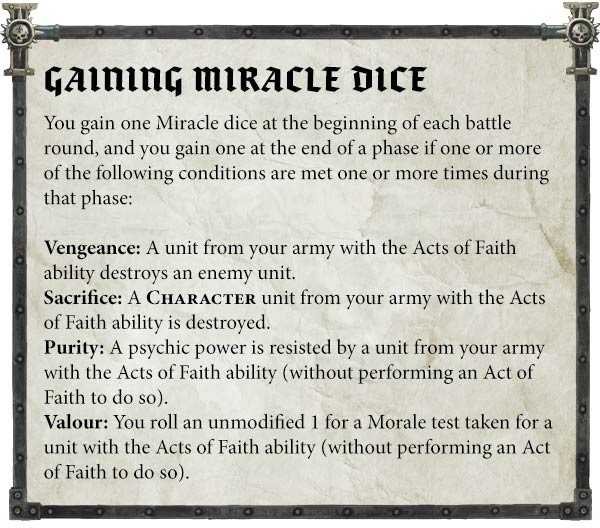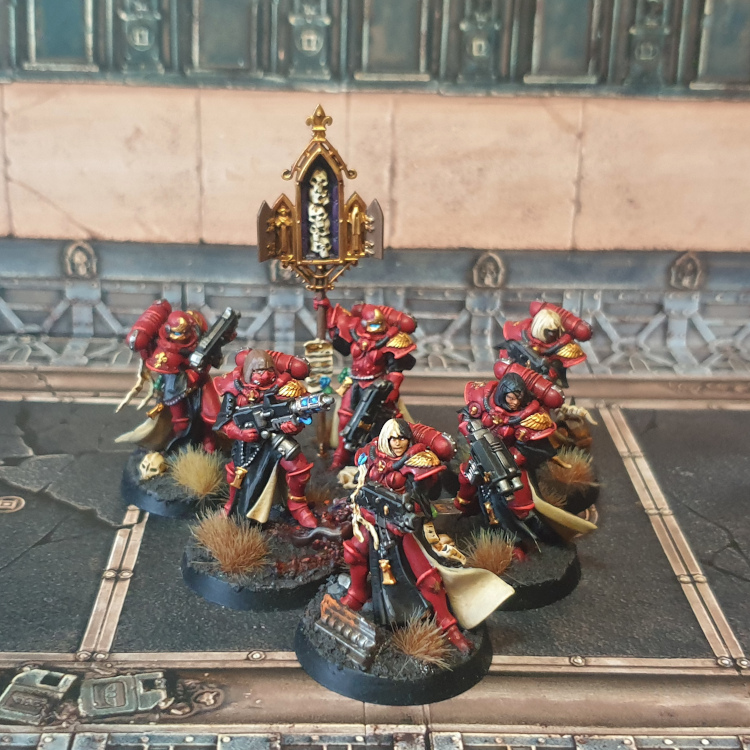Tis the season, so this week’s Hammer of Math will cover one of the defining features of the Adepta Sororitas: Miracle dice and Acts of Faith. Special thanks to reader Tim Pinney for providing some much needed insight with this article.

Along with some of the nicest models in the 40k range, the release of the Sisters of Battle brought about a fascinating rule in the form of Acts of Faith. During the course of the game the player generates Miracle dice in various ways. Every time a Miracle dice is gained, the player rolls a d6 and keeps track of the result. The Miracle dice are kept in a pool to be used later on.

Once per phase the player can perform an Act of Faith to apply one result from the Miracle dice pool to a particular die roll. No roll is made, instead the Miracle dice becomes the result of that particular roll. The result cannot be replaced by a re-roll (so if e.g. you used one dice for a charge and rolled the other, a subsequent re-roll would only change the second dice, unlike what normally happens). This process is called a Miracle dice substitution, and can be performed on a limited number of rolls:
- Advance roll
- Charge roll
- Deny the Witch test
- Hit roll
- Wound roll
- Saving throw
- Damage roll
- Morale test
This ability can be further enhanced by several units, abilities, and Stratagems. One notable unit is the Triumph of Saint Katherine, an actual funeral procession marching solemnly through the battlefield while bolter fire and flamer blasts fill the air. This unit contains several relics which impact Miracle dice, notably the Censer of the Sacred Rose which generates an additional Miracle dice at the beginning of each turn (yours and your opponent’s) and the Icon of the Valorous Heart which allows an additional Act of Faith to be performed. The Simulacrum of the Argent Shroud allows you to increase or decrease the value of one Miracle dice used by 1 before its use, to a maximum of 6 and a minimum of 1. This effect is identical to the Dialogus and her Stirring Rhetoric ability. Additionally, units with access to a Simulacrum Imperialis can have an Act of Faith performed on them even if another has already been performed. Units of Repentia also generate a Miracle dice when destroyed with their Martyrdom special rule, unless it was in the Morale phase.
For abilities, the Order of Our Martyred Lady gain Miracle dice at the end of any phase (other than Morale) in which a unit is destroyed. The Order of the Ebon Chalice has a very powerful ability which allows them to discard a Miracle dice to make a Miracle dice used in an Act of Faith to be considered a 6. Finally the Order of the Sacred Rose gains a Miracle dice on a roll of a 5+ after each Act of Faith is performed.
There are several Stratagems that also apply. Moment of Grace (1 CP) allows you to sacrifice multiple dice to add 1 to the result of a failed hit roll, wound roll, or saving throw for each dice sacrificed. Not that you still cannot get higher than a +1 modifier on a hit or wound roll. Faith and Fury (2 CP) allows you to use the same Miracle dice for a hit roll and wound roll. Vessel of the Emperor’s Will (1 CP) allows you to gain a Miracle dice after performing an Act of Faith for a CHARACTER, while Test of Faith (1 CP) provides D3 additional Miracle dice for Purity or Valour. Warlords with the Beacon of Faith ability also generate a Miracle dice at the start of each turn, those with the Light of the Emperor trait can gain one Miracle dice when performing an Act of Faith for the Warlord, and the first Miracle dice generated for a Warlord with the Terrible Knowledge trait is automatically a six. The presence of the Litanies of Faith Relic allows you to re-roll the result of a gained Miracle dice once per turn.
All told there is an awful lot going on here – it’s an entire sub-system in itself, unique to the army and surprisingly complex to get a handle on when you start playing (or playing against) Sisters.

The Math of Faith
The phase-based limitation on Acts of Faith primarily affects the hit roll, wound roll, and damage dealt by an attack. Before each roll the player must decide which value to affect, and in the case of the Order of the Ebon Chalice whether or not it’s worth sacrificing an additional Miracle dice to ensure a result of a 6. As we’re well aware of by now the basic 40K roll is divided into gatekeeper rolls (hit, wound, save, FNP) and driving rolls (damage, attacks). In the case of an attack against a particular target the question becomes whether or not there’s a situation in which it is better to substitute a gatekeeper roll instead of a driver roll. For example let’s say you have a Retributor Squad firing a multi-melta at a T9 target. The Retributor Superior is armed with a combi-flamer so that Holy Trinity (1 CP) is activated to provide +1 to wound, and Storm of Retribution (2 CP) is activated to add 12” to the Range characteristic of the multi-melta and 1 to the damage roll. As a result the attack hits on a 3+, wounds on a 4+, and will deal 1d6+3 damage. Which rolls do you substitute?
To solve this problem we look at it from an expected value perspective.
Expected Damage = P(Hit) * P(Wound) * (1 – P(Save)) * (1 – P(FNP)) * Damage
Our goal is to find out which solution will improve the expected damage the most; eliminating the probability associated with a particular roll or improving the damage relative to the average value? To do this we take the damage value provided by the Miracle dice result, divide it by the average damage inflicted, and take the inverse of that value. The result is the maximum probability that we would want to disregard before it’s better to improve the damage. Note that when looking at a Hit and Wound roll we always want to substitute the roll with the lowest probability, as that will have the greatest impact.
For example, let’s say we have a weapon with a damage of 1d6 and our Miracle dice is 6. The average of a 1d6 is 3.5, so if we divide 6 by 3.5 we get 1.71. If we take the inverse of that we get 0.583, or 58.3%. Therefore if the hit or wound roll is a 4+ or worse, we would want to substitute that target before we substituted the damage. We can work out the math to see that’s true. 50% multiplied by a damage of 6 is 3, while 100% multiplied by a damage of 3.5 is 3.5 and therefore more. On the other hand multiplying 66% times 6 gets us a value of 4, which is greater than 3.5.
The resulting probabilities are found in the chart below.

Note that for values that are less than the average roll it’s never advantageous to substitute a Miracle dice for a damage roll (unless the target is at low health and your goal is to guarantee a kill). For higher values the substitution target depends on the value of the Miracle dice as well as the probability of success. The chart below takes the percentages from the calculations and converts them into d6 target numbers.

The way to read this chart is to look at the combination of damage value and your available Miracle dice. Then look at the corresponding target value. If that target value is better than the specified roll then you should substitute the damage roll, otherwise substitute the hit or wound roll.

Multiple Acts and Faith and Fury
What happens if you have an opportunity to substitute multiple rolls in an attack sequence? Do you substitute both the hit and wound roll, or do you substitute one or the damage roll? Or if you’re dealing with multiple attacks do you substitute one gatekeeper roll on two different attacks? In this case our goal is still to maximize the total damage dealt, so we can follow this process:
- Replace the worst hit/wound roll in multiple attacks.
- If you have more Acts of Faith available than attacks, consult the chart for the lowest of the hit/wound roll targets and apply to as many attacks as possible.
- If you have any Acts of Faith remaining, then consult the chart for the higher of the hit/wound roll targets and apply.
The Faith and Fury (2 CP) Stratagem effectively applies two dice, but it can only work on a sequential hit and wound roll. The chart below provides the cumulative probabilities of a pair of hit and wound rolls, which can then be applied to the probability chart to see if the approach is better than substituting the damage roll. In general it is, as even a pair of 2+ rolls is equivalent to a single 3+ roll in terms of probability of success. The high cost of Faith and Fury makes it preferable for final strikes against wounded targets; for the cost of 2 CP you can guarantee that a particular attack hits and wounds the target. If you have access to a second Act of Faith (for example by using the Triumph’s ability) then you can even guarantee the damage roll.

Fast Rolling
Normally players declare their attacks and fast roll all identical attacks simultaneously. It’s easy and convenient, and when the rolls are independent of one another the impact is minimal. In the case of Acts of Faith it’s also less than optimal due to the possibility of wasting or misusing Miracle dice. As the number of wounds on the target decreases it may be advantageous to change your strategy to maximize your chances of killing the target. Because the decision to use a Miracle dice occurs immediately before the roll, you may want to hold off on using them if the target is already dead or sufficiently weak. To accommodate this you can use the following process:
- Determine how many Acts of Faith you can perform and set aside that many attacks.
- Fast roll the attacks that weren’t set aside.
- Resolve the remaining attacks one by one, applying Miracle dice where appropriate.
Probability of Kill: When to Ignore the Chart
The strategies above are intended to maximize the statistical advantage of using Miracle dice in situations where your options are limited. The exception is when the target has fewer wounds than the damage capability of the attack, and you’re now looking at whether or not a particular attack will kill a target instead of just maximizing damage. In that situation you can treat the damage roll as its own gatekeeper, with the probability being the chance that the damage inflicted is greater than the wounds remaining on the target. In that situation you would want to substitute whatever value will maximize the probability of killing the target.
For example if I have a weapon that deals 1d6 damage and the target has 6 wounds left, I have a 17% chance of killing it. If my hit roll is a 4+ and my Miracle dice is a 6 I would still want to substitute the damage roll instead of the hit roll even though the chart says I will deal more damage by replacing the hit roll. This is because my goal is now to kill the target, and not just deal the most amount of damage possible. This is also a good example of why you would want to save your Miracle dice for the last attacks in the sequence.

Wrapping Up
Acts of Faith are a fascinating part of the Adepta Sororitas, and offer a unique and fun way to change the tide of battle. When properly applied they can turn the tide of battle, removing uncertainty. Definitely a cool ability for an awesome army.
- While modifying the damage result is very powerful, often the improvement in eliminating the probability of a hit or wound roll is greater than changing the damage roll relative to the average result.
- When using multiple Acts of Faith, it’s generally better to substitute the worst hit/wound roll value on multiple attacks.
- When fast rolling, set aside a number of attacks equal to the number of Acts of Faith you intend to perform and then fast roll the remainder before determining how to apply your Miracle dice.
- Faith and Fury is an excellent way to finish off a high value target.
- Against targets with fewer wounds than the amount of damage able to be inflicted by the attack, consider regarding the damage roll as a gatekeeper with a probability of killing the target.
Thanks for reading! If you have any feedback, feel free to drop a note in the comments below or email us at contact@goonhammer.com. If you have any questions that you would like answered in a future article like this one, please submit them here.
Finally thanks again to Tim Pinney for his insight and suggestions with this article. Tim is a member of Team Brohammer and is a frequent guest on the Sister Act Podcast.


